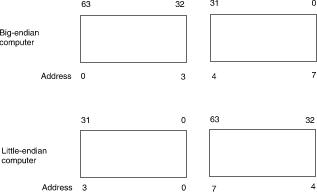Data types and formats
Single-precision
Single-precision floating point numbers have the following format:
|
31
|
30
|
23
|
22
|
0
|
|---|
|
SIGN
|
EXPONENT
|
FRACTION
|
|---|
|
|
|
|
^
|
|
|
|
|
|
binary point
|
|
|
Field
|
Position
|
Full Name
|
|---|
|
sign
|
31
|
sign bit (0==positive, 1==negative)
|
|---|
|
exponent
|
30-23
|
exponent (biased by 127)
|
|
fraction
|
22-0
|
fraction (bits to right of binary point)
|
Double-precision
Double-precision floating point numbers have the following format:
|
63
|
62
|
52
|
51
|
0
|
|---|
|
SIGN
|
EXPONENT
|
FRACTION
|
|---|
|
|
|
|
^
|
|
|
|
|
|
binary point
|
|
|
Field
|
Position
|
Full Name
|
|---|
|
sign
|
63
|
sign bit (0==positive, 1==negative)
|
|---|
|
exponent
|
62-52
|
exponent (biased by 1023)
|
|
fraction
|
51-0
|
fraction (bits to right of binary point)
|
NOTE:
For big-endian machines, the high-order word is at the low address;
for little-endian machines,
the high-order word is at the high address:

Extended-precision
Extended-precision floating point numbers have the following format
on the Intel386 microprocessor:
microprocessor:
|
79
|
78
|
64
|
63
|
0
|
|---|
|
SIGN
|
EXPONENT
|
FRACTION
|
|---|
|
|
|
|
^
|
|
|
|
|
|
binary point
|
|
For extended precision, bit 63 is always a 1, and the decimal
point comes after this bit.
The other formats have an
implicit bit 1 before the fraction, as explained in
``Normalized numbers''.
|
Field
|
Position
|
Full Name
|
|---|
|
sign
|
79
|
sign bit (0==positive, 1==negative)
|
|---|
|
exponent
|
78-64
|
exponent (biased by 16,383)
|
|
fraction
|
63-0
|
fraction (bit 63=1, followed by the
|
|
|
|
decimal point. Bits 62-0 are the fraction.
|
Next topic:
Normalized numbers
Previous topic:
IEEE arithmetic
© 2005 The SCO Group, Inc. All rights reserved.
SCO OpenServer Release 6.0.0 -- 02 June 2005


 microprocessor:
microprocessor: